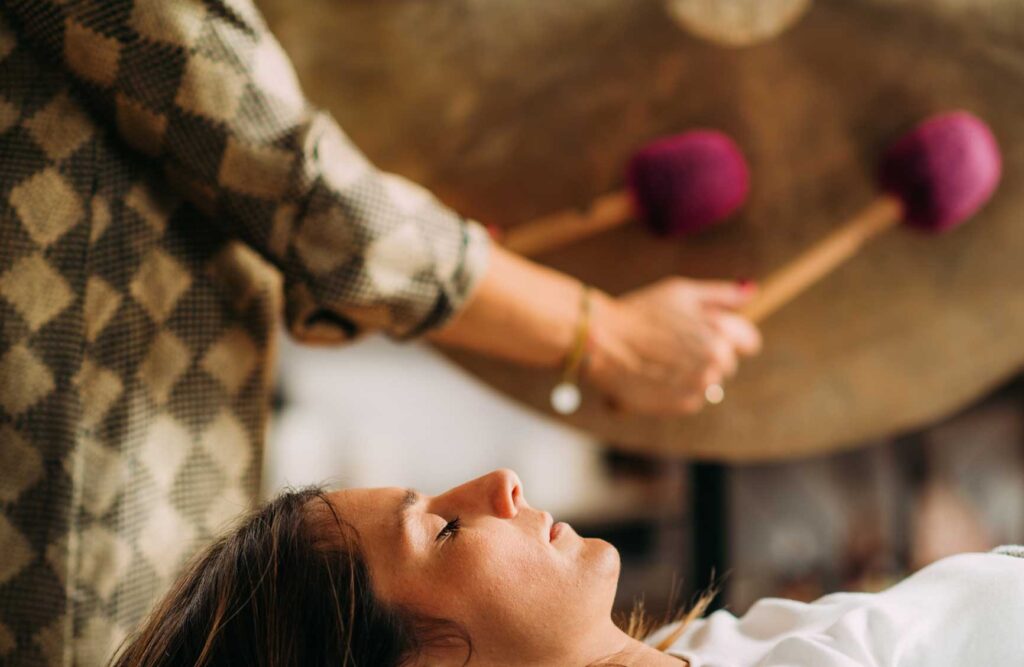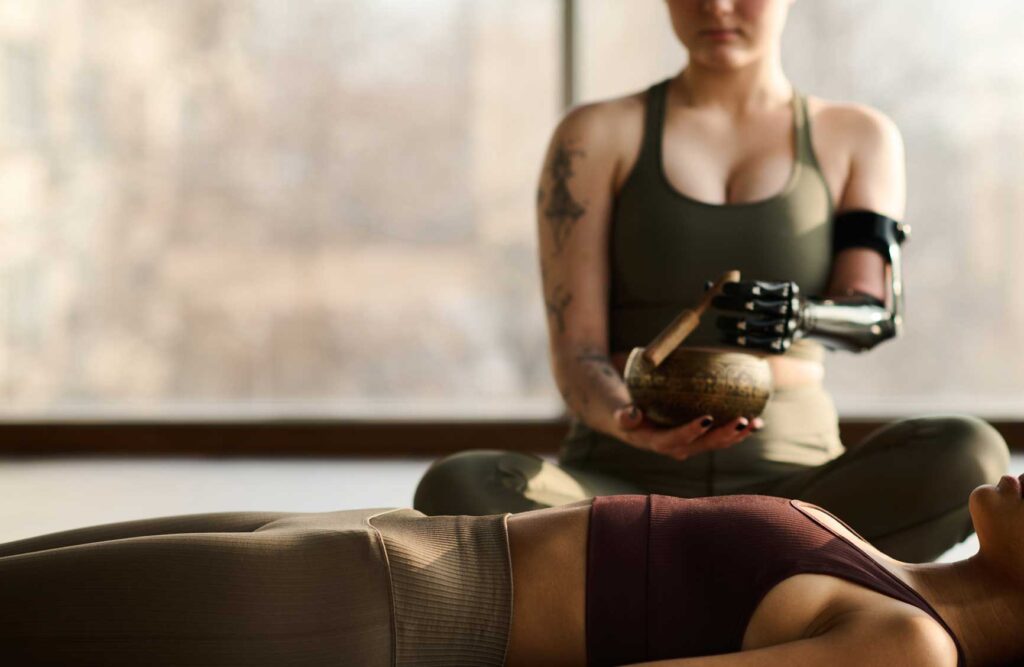The world of yoga, much like the fluid postures and sequences it promotes, is in a constant state of evolution. From ancient ashrams in India to contemporary studios in big cities, yoga has danced through time, adapting and reinventing itself. For practitioners and studio owners alike, staying on top of these shifts isn’t just a luxury—it’s a necessity. Especially given the rapid growth trajectory the yoga market is poised for.
With a forecasted market size reaching jaw-dropping figures, the opportunities are just waiting to be seized. But what trends will define this vibrant landscape in 2024? What new forms will yoga take, and how can studios adapt? Join us as we unveil the seven trends that are bound to shape the yoga world next year.
Unfolding the Future: 7 Transformative Yoga Trends for 2024
1. Virtual Reality Yoga Retreats
The lines between the digital realm and reality have been blurring for a while now, and the yoga world isn’t untouched by this technological marvel. Imagine immersing yourself in the tranquil surroundings of the Himalayas or feeling the gentle caress of ocean waves, all from the comfort of your local studio or home. That’s the promise of Virtual Reality (VR) Yoga Retreats.
Description: By using a VR headset, practitioners are transported to serene environments, curated to enhance their meditative experience. It’s the synthesis of technology and tradition, offering a unique escape that caters to the modern yogi’s lifestyle.
Potential Impact: This trend could revolutionize the concept of yoga retreats. Traditionally, these retreats, while being transformative, can often be pricey and require extensive travel. VR retreats offer a more accessible and affordable alternative, bringing exotic locations within reach of many.
Tips for Studios: To tap into this burgeoning trend, studios might consider investing in high-quality VR equipment. Collaborating with VR content creators can help design immersive yoga experiences. Additionally, studios can offer monthly VR retreat sessions or packages, allowing members to ‘travel’ to new destinations regularly.
2. Sound Bath Meditation
The healing power of sound is an ancient practice, but its resurgence in the yoga community is noteworthy. More than just a background tune, sound bath meditation offers an immersive, auditory experience that resonates deeply within practitioners.
Description: Sound bath meditation employs instruments such as crystal bowls, gongs, and chimes to produce vibrations that reverberate throughout the room. As participants lie down and relax, these resonating sounds envelop them, facilitating a profound meditative state.
Potential Impact: In an increasingly noisy world, the allure of sound bath meditation lies in its ability to provide solace and tranquility. For studios, introducing sound bath sessions can serve as a unique offering, setting them apart from competitors. It also appeals to individuals seeking alternative relaxation and stress-relief techniques.
Tips for Studios: Collaborating with trained sound therapists can elevate the quality of sessions. Alternatively, studios might consider investing in premium sound instruments and offering dedicated training to instructors. Promotional workshops or trial classes can be an effective way to introduce clients to this enriching experience.

3. Eco-friendly Yoga Practices
Yoga has always embraced harmony — not just within ourselves but with our environment. The rise of eco-friendly yoga practices signifies a collective movement toward environmental responsibility within the yoga community.
Description: This trend extends beyond using eco-friendly mats and props; it’s about embedding sustainability into every facet of a yoga practice. From utilizing energy-efficient lighting and heating in studios to promoting apparel made from recycled materials, it represents a holistic approach to ecological mindfulness.
Potential Impact: Adopting eco-friendly practices not only minimizes the carbon footprint of studios but also attracts like-minded practitioners who prioritize sustainability. It builds a community centered around shared values of environmental conservation, enhancing the collective ethos of the studio.
Tips for Studios: Begin by assessing and adapting the tangible aspects like mats, props, and studio utilities. Collaborate with sustainable brands and local artisans for retail products. Consider organizing events or workshops focused on eco-conscious living, intertwining the values of yoga with those of sustainability.
Incorporating eco-consciousness into your studio’s operational and philosophical framework not only demonstrates responsibility but also honors the ancient yoga principle of ‘Ahimsa’ (non-harming). Nurturing a space that reflects these principles will not only be rewarding for the environment but also for the community you build and engage with.
4. Personalized Yoga Therapy
The one-size-fits-all approach is gradually fading in many sectors, and yoga is no exception. Personalized yoga therapy is stepping into the limelight, offering tailored sessions that cater to the unique needs of each individual.
Description: Unlike traditional group classes, personalized yoga therapy sessions are meticulously designed around a practitioner’s specific health concerns, goals, or even life situations. Whether it’s managing chronic pain, emotional healing, or addressing specific physical challenges, these sessions dive deep into providing therapeutic solutions.
Potential Impact: Offering such personalized attention ensures not only better health outcomes for participants but also fosters a deeper bond between them and the studio. It sets the tone for a more intimate and understanding instructor-student relationship, underpinning the importance of individual care in a group setting.
Tips for Studios: Investing in instructors trained in yoga therapy is a must. Encourage continual learning and specialization among staff. Studios can promote therapy sessions as packages, emphasizing the benefits of personalized care. Furthermore, gathering feedback after sessions and making iterative adjustments can help in refining this service further.
As we emphasize the union of body, mind, and spirit in yoga, recognizing and addressing the unique journeys of each practitioner enriches the holistic experience. Ready to uncover the next wave of change in the yoga landscape? Let’s continue our exploration.

5. Hybrid Classes (Yoga + Other Disciplines)
Diversity is the spice of life, and the yoga world is embracing this mantra wholeheartedly. The emergence of hybrid classes, where yoga melds with other fitness disciplines, showcases this innovative approach.
Description: Think yoga meets pilates, or a blend of dance rhythms and asanas, or even the incorporation of strength training into traditional yoga sequences. These hybrid classes offer a dynamic, multifaceted workout, tapping into the best of both worlds.
Potential Impact: These classes can appeal to a broader audience, especially those who are looking for comprehensive fitness solutions without having to juggle multiple classes or studios. It’s about optimizing time while maximizing benefits — offering a fresh, exciting twist to standard routines.
Tips for Studios: Collaborate with experts from other fitness disciplines to design engaging and effective class structures. Offer trial sessions or workshops to introduce these hybrid classes to members. Gathering feedback can help in fine-tuning the sessions to better cater to the preferences of practitioners.
By merging the spiritual and meditative essence of yoga with the vitality of other disciplines, hybrid classes promise a rejuvenating experience that caters to both the body and soul. As we continue our deep dive into 2024’s yoga trends, the tapestry of innovations only gets richer.
6. Inclusivity and Accessibility in Yoga
Breaking barriers and bridging divides, yoga is steadily championing the cause of inclusivity and accessibility. This trend underscores the core tenet of yoga: It is for everyone, irrespective of age, ability, or background.
Description: Inclusivity in yoga means offering classes that cater to all demographics, be it seniors, people of all abilities, or people from diverse cultural backgrounds. This encompasses modifying asanas, using props creatively, and ensuring that studio spaces are physically accessible.
Potential Impact: An inclusive approach not only broadens the client base for studios but also upholds the true essence of yoga — union. By creating a welcoming environment for everyone, studios can build a diverse community, enriching the overall experience with varied perspectives and experiences.
Tips for Studios:
- Offer specialized classes such as chair yoga, prenatal yoga, or sessions tailored for individuals with specific conditions.
- Engage in regular training to sensitize instructors towards diverse needs.
- Ensure that the studio’s infrastructure — ramps, wide doorways, accessible washrooms — caters to all.
Inclusivity doesn’t stop at physical accessibility; it’s also about ensuring that everyone feels seen, heard, and valued. Embracing this trend is more than a business strategy; it’s about fostering community and unity.

7. Mindful Technology Integration
The surge in digitalization across industries has touched the realm of yoga too. However, the emphasis in the yoga community is on ‘mindful’ integration, ensuring that technology enhances rather than detracts from the experience.
Description: Mindful technology integration is not just about offering online classes. It’s about leveraging technology to provide customized session recommendations, real-time posture corrections using AI, or even creating digital platforms for community interactions. The idea is to use tech in a way that aligns with the mindful and present essence of yoga.
Potential Impact: This trend could significantly expand the reach of yoga studios, making yoga more accessible to people globally. It also offers opportunities for studios to diversify their services, ensuring they remain relevant in an increasingly digital world.
Tips for Studios:
- Collaborate with tech companies to integrate the latest innovations that cater specifically to yoga practices.
- Offer blended classes, where in-person and virtual participants can engage in the same session.
- Prioritize user experience in any digital platform or app to ensure it’s intuitive and aligns with the meditative essence of yoga.
Conclusion: Embracing the Future of Yoga
As we’ve journeyed through the evolving landscape of yoga, one thing remains clear: the essence of yoga, rooted in ancient traditions, continues to adapt and flourish in our modern world. Each trend underscores the commitment of the yoga community to innovation, inclusivity, and a holistic experience.
For studio owners and practitioners keen on embracing this dynamic future, having the right tools is crucial. Consider using Mariana Tek’s Yoga Studio Software — a state-of-the-art solution designed to elevate your studio’s operations and align with these emerging trends. By seamlessly integrating advanced features and user-friendly interfaces, Mariana Tek ensures that as the world of yoga evolves, you’re always one step ahead.
Whether you’re just beginning your yoga journey or are a seasoned practitioner, the future promises exciting, transformative possibilities. Here’s to a future where tradition and innovation coalesce, creating a yoga experience like never before.
by Xplor Mariana Tek
-
First published: October 25 2023
Written by: Xplor Mariana Tek
